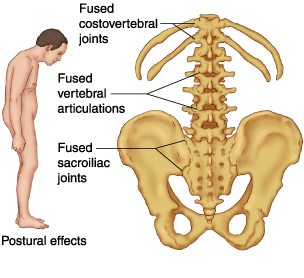
Ankylosing Spondylitis is a painful arthritis that affects the spine. The disease process often starts in adolescents and there is a male predominance. Symptoms often begin in the sacroiliac joints, where the bones of the sacrum and ilium come together. Pain and stiffness are the main symptoms. The pain originates in the lower back and may radiate down the legs. The bones of the spine may become fused, limiting mobility and function. Tendons may be affected such as the achilles tendon in the back of your heel. Ankylosing spondylitis is also a systemic disease. Patients may experience fever, fatigue and loss of appetite. It may affect the eyes, heart and lung as well. Ankylosing spondylitis is an inherited genetic disease. People with this problem have the HLA-B27 gene. Treatment of ankylosing spondylitis is multifactorial. X-rays and MRI scans can be useful to diagnose and describe the extent of the disease. Physical therapy plays a large part to limit loss of function and preserve mobility. Non-steroidal anti-inflammatory medications are used to control the pain. In moderate cases, disease modifying anti-rheumatic drugs can be used such as methotrexate. Newer drugs called biologics, such as Embrel and Humira have been added as well. Epidural steroid injections may also be useful to control the pain associated with spinal symtpoms.